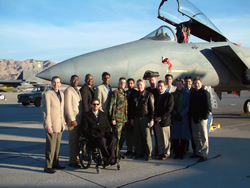
- Purpose
- History
- Press Releases
- Newsletter
- Become a Fellow
- Selection Process
- Calendar and Procedures
- Work Placement
- Education Program
- Community Service
- Fellowship
- Application and Directions
- Frequently Asked Questions
- Alumni
- Class of 2008-2009
- Photos of Former Classes
- The Commission
- Commissioner Service Dates
- Director's Biography
- Contacts
|
Home >
Government >
White House Fellows
|

| Spring 2003 | VOLUME 27 | Number 2 |
Fellows Head West
The 2002-2003 class of White House Fellows recently traveled to Texas and Nevada to examine a range of domestic policy and military issues. During their second domestic policy study trip, the class visited Austin and Houston in January to study Texas as a microcosm of pressing national issues. In February, the class had an up-close look at the U.S. Air Force while touring Nellis Air Force Base in Nevada.
Texas
In the Lone Star State, the class discussed a wide range of issues in meetings with key Texas officials including: Health and Human Services Commissioner Albert Hawkins; First Assistant Attorney General Barry McBee (‘89-90); Associate Justice Priscilla Owen; Texas Governor Rick Perry; U.S. Attorney Johnny Sutton; Secretary of State Gwyn Shea; Governor Perry’s Chief of Staff Mike Toomey; and Texas Railroad Commissioner Michael Williams.
 The class at the NASA with Astronauts Peggy Whitson, PhD and USAF Colonel Carol Walz. |
The class experienced the NASA Johnson Space Center in action through a series of high-level briefings and tours, including Mission Control and the Neutral Buoyancy Laboratory. The NASA visit was particularly memorable, as later that week the nation lost the Space Shuttle Columbia. David Carmel (‘02-03) provides his reflections:
The most powerful part of the trip was our visit to NASA’s Johnson Space Center. We met with astronauts Colonel Carl Walz and Dr. Peggy Whitson to became familiar with the rigors of selection, training, and space missions. At the Mission Control Center, we observed the Space Shuttle Columbia as it was orbiting the earth. These experiences made the Columbia disaster real and personal. It also begged the question – ‘What should be America’s role in space?’
Nellis AFB
 The 2002-03 White House Fellows class at Nellis Air Force Base, Nevada with an F-15 Eagle fighter jet |
with U.S. Air Force (USAF) Secretary James G. Roche as they traveled via military airlift from Andrews AFB to Nellis AFB. En route to Nellis, the class witnessed an in-flight refueling of a B-2 Spirit Bomber aboard an Air Mobility Command KC-10.
Once on the ground at Nellis, the trip was an opportunity for the class to learn about the operations of the USAF, its culture, aircraft, and weapons systems. The Fellows had rich interactions with the men and women of the Air Force in formal and informal settings. At a breakfast with young airmen, the Fellows gained insights on their motivation to serve, the sacrifices, and commitment to the USAF.
Over a three-day period, the class experienced a range of specialized trainings and demonstrations. This included comprehensive tactical and operational briefings from the USAF Air Demonstration Squadron "Thunderbirds," the 414th "Red Flag" Air Combat Training Center, and the Air Combat Training System Demonstration. The Fellows participated in a flight line tour and threat training facility tour, and also witnessed technology applications through the Predator Unmanned Aircraft Training Facility, the F/A 22 Raptor Test Unit, and the Weapons Training School.
The highlight of the trip was the Firepower Demonstration held annually in the Nevada desert. The class witnessed nearly every aircraft in the Air Force inventory dropping some of the latest munitions. The scripted scenarios provided a better understanding of how each aircraft is used to accomplish different missions. In addition to observing the B-1, B-2 and the B-52, the class saw numerous low flying fighters including the F-15, F-15E (Strike Eagle), F-16, F-117 (stealth fighter), and the A-10. Transport aircraft (including the C-17) and Special ops helicopters also were flying that day.
On the flight back to Andrews AFB, the class again observed an in-flight refueling
of three F-117 Stealth Fighters. The Fellows returned to Washington with a greater
understanding of how the Air Force functions at the operational and tactical
level.
| [ Previous | Home | Next ] |
